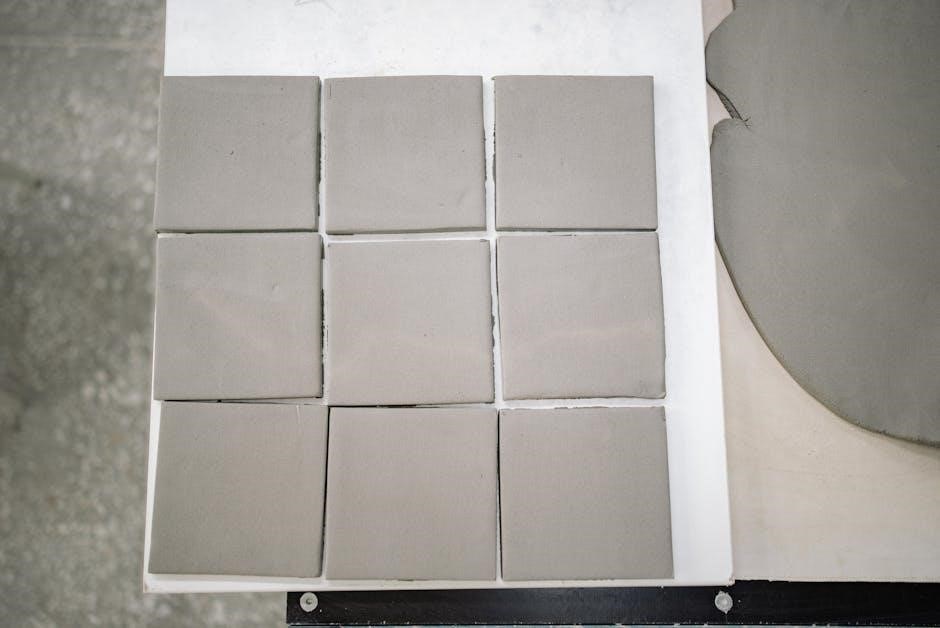list of construction materials pdf
Construction materials are essential for building projects, classified into main materials like rocks, artificial stones, timber, and metals, and binding materials such as cement and lime.
1.1 Overview of Construction Materials
Construction materials form the backbone of building projects, encompassing a wide range of substances used to create structures. These materials are broadly categorized into natural and synthetic types, including rocks, artificial stones, timber, metals, and binding agents like cement and lime. Common materials such as concrete, steel, wood, glass, and plastics are widely used due to their strength, durability, and versatility. Additionally, specialized materials like insulation, roofing, and smart materials address specific needs in modern construction. The selection of materials depends on their properties, such as strength, thermal resistance, and sustainability, ensuring functionality and longevity in various applications. Proper material selection is crucial for successful project outcomes.
1.2 Importance of Construction Materials in Building Projects
Construction materials are vital for ensuring the structural integrity, safety, and durability of buildings. They form the foundation of all construction projects, determining the strength, stability, and longevity of structures. The right materials ensure compliance with safety standards, while their quality directly impacts the overall performance of a building. Additionally, materials influence cost-effectiveness, environmental sustainability, and aesthetic appeal. Proper selection and use of materials like concrete, steel, wood, and glass are essential for achieving desired outcomes in construction, making them a critical factor in successful project execution and long-term satisfaction.

Classification of Construction Materials
Construction materials are categorized based on their origin, properties, and applications, such as natural, synthetic, binding, and specialized materials, ensuring functionality and durability in building projects.
2.1 Natural vs. Synthetic Materials
Construction materials are broadly classified into natural and synthetic categories. Natural materials, such as wood, stone, clay, and soil, are derived directly from the earth with minimal processing. They are often eco-friendly and blend seamlessly into traditional designs. Synthetic materials, like plastics, steel, and cement, are man-made, offering enhanced durability and versatility. This classification helps in understanding their origins, properties, and applications, enabling better decision-making in construction projects. Natural materials are prized for their aesthetic appeal, while synthetic ones are valued for their strength and adaptability, catering to diverse building needs and environmental conditions.
2.2 Main Building Materials: Rocks, Artificial Stones, Timber, and Metals
Rocks, artificial stones, timber, and metals are fundamental building materials. Rocks, like granite and sandstone, are durable and used for structural elements. Artificial stones, such as concrete blocks and bricks, offer versatility and strength. Timber, sourced from trees, is a renewable resource used for framing, flooring, and finishes. Metals, including steel and aluminum, provide high strength-to-weight ratios and are essential for frameworks and reinforcements. Each material has unique properties, making them suitable for specific applications in construction, ensuring stability, safety, and aesthetic appeal in various building projects.
2.3 Binding Materials: Cement, Lime, and Adhesives
Binding materials like cement, lime, and adhesives are essential for holding construction elements together. Cement is a primary binder in concrete, offering strength and durability. Lime is used in mortars and plasters, providing flexibility and breathability. Adhesives, such as epoxy and acrylic, bond diverse materials like wood, metal, and glass. These materials ensure structural integrity, enhance durability, and improve the overall performance of buildings. Their versatility and binding properties make them indispensable in modern and traditional construction techniques, enabling the creation of stable and long-lasting structures across various applications.

Common Construction Materials
This section explores widely used construction materials, such as concrete, steel, wood, bricks, glass, and plastics, highlighting their applications and importance in building projects effectively.

3.1 Concrete and Its Applications
Concrete is a versatile and widely used construction material, made from a mixture of cement, water, and aggregates like sand or gravel. Known for its strength and durability, it is a cornerstone in building foundations, walls, and floors. Concrete is also used in infrastructure projects, such as roads, bridges, and dams. Its ability to be molded into various shapes before hardening makes it ideal for structural and decorative elements. Additionally, concrete offers fire resistance and low maintenance, making it a cost-effective and sustainable choice for modern construction. Its applications are limitless, from residential buildings to large-scale civil engineering projects.
3.2 Steel and Its Role in Modern Construction
Steel is a fundamental material in modern construction, prized for its high strength, durability, and versatility. Used extensively in frameworks, beams, and reinforcing structures, steel enables the construction of tall buildings, bridges, and complex designs. Its high strength-to-weight ratio makes it ideal for large-scale projects. Steel is also adaptable, available in various forms like beams, columns, and reinforced bars. Its resistance to harsh conditions and ability to withstand heavy loads ensure long-lasting structures. Steel’s recyclability adds to its sustainability, making it a preferred choice for both traditional and innovative construction projects. Its applications continue to expand, shaping the future of building design.
3.3 Wood and Wood Products in Construction
Wood and wood products are versatile and widely used in construction due to their natural beauty, strength, and sustainability. Common applications include framing, flooring, roofing, and interior finishes. Wood is lightweight yet durable, making it ideal for structural and decorative purposes. Engineered wood products, such as plywood and laminated beams, offer enhanced strength and stability. Wood is also a renewable resource, contributing to sustainable building practices. Its thermal insulation properties and aesthetic appeal make it a preferred choice for both traditional and modern designs. Treated wood and composites further extend its durability, ensuring longevity in various environmental conditions.
3.4 Masonry Materials: Bricks, Blocks, and Stones
Masonry materials like bricks, blocks, and stones are fundamental in construction for building durable structures. Bricks, made from clay, are versatile and weather-resistant, commonly used in exterior walls. Concrete blocks, larger and stronger, are ideal for load-bearing applications. Natural stones, such as granite and marble, offer both strength and aesthetic appeal, often used in decorative features and facades. These materials are valued for their durability, fire resistance, and low maintenance requirements, making them popular choices for both functional and decorative purposes in construction projects.
3.5 Glass and Its Uses in Construction
Glass is a versatile material in construction, valued for its transparency, durability, and aesthetic appeal. Common uses include windows, doors, facades, and interior partitions. Tempered and laminated glass are popular for their strength and safety features. Insulated glass units reduce heat transfer, enhancing energy efficiency. Glass is also used in roofing, skylights, and decorative elements like balustrades. Its ability to allow natural light while providing weather protection makes it a key material in modern architecture, blending functionality with visual appeal for both residential and commercial buildings.
3.6 Plastics and Polymers in Building Applications
Plastics and polymers are increasingly used in construction due to their durability, lightweight, and resistance to corrosion; Common applications include PVC pipes, insulation materials, and vinyl siding. Polymers enhance concrete strength and are used in composite materials like fiber-reinforced polymers. They also serve as sealants, adhesives, and coatings, improving weather resistance. Modern advancements include recycled plastics for decking and polymer-modified asphalts for roads. Their versatility and low maintenance make plastics and polymers essential in sustainable and innovative building designs, offering cost-effective solutions while meeting performance demands in various construction projects.

Specialized Construction Materials
Specialized construction materials like insulation, advanced roofing, and smart technologies enhance building performance. These materials offer thermal, acoustic, and adaptive solutions, improving energy efficiency, safety, and sustainability in modern constructions.
4.1 Insulation Materials: Thermal and Acoustic
Insulation materials are crucial for reducing heat transfer and noise in buildings. Thermal insulation, such as mineral wool, fiberglass, and foam boards, minimizes energy loss, improving energy efficiency. Acoustic insulation materials, like mass-loaded vinyl and acoustic panels, reduce sound transmission, enhancing indoor comfort. These materials are applied in walls, floors, and ceilings to create quieter and more climate-controlled environments. Proper insulation not only lowers energy costs but also contributes to sustainability by reducing heating and cooling demands. Advanced insulation solutions are now being integrated into modern construction to meet stricter energy-efficiency standards and promote eco-friendly building practices.
4.2 Roofing Materials: Types and Applications
Roofing materials are essential for protecting buildings from weather conditions while ensuring durability and aesthetics. Common types include asphalt shingles, known for affordability and ease of installation; clay tiles, offering durability and fire resistance; metal roofing, praised for its strength and long lifespan; and slate, a premium option for its luxurious appearance. Modern solutions like fiberglass roofing and rubber roofing provide versatility. Additionally, solar roof tiles integrate renewable energy, while green roofs incorporate vegetation for environmental benefits. Each material is chosen based on climate, budget, and structural requirements, ensuring functional and appealing roofing solutions for diverse construction needs.
4.3 Smart Materials and Their Role in Modern Construction
Smart materials are innovative substances that respond to environmental changes, enhancing construction efficiency and sustainability. Examples include shape memory alloys, which return to their original form when heated, and self-healing concrete, incorporating bacteria to repair cracks. Thermochromic materials change color with temperature, reducing heat absorption, while piezoelectric materials generate electricity from mechanical stress. These materials improve energy efficiency, durability, and safety in buildings. Their adaptive properties enable smarter infrastructure, reducing maintenance needs and environmental impact. Smart materials are revolutionizing construction, offering solutions for modern challenges like climate change and urbanization, while paving the way for futuristic, responsive buildings.

Sustainable and Eco-Friendly Materials
Sustainable materials like bamboo, recycled steel, and low-carbon concrete reduce environmental impact. They promote energy efficiency and minimize waste, aligning with green building standards and global sustainability goals.
5.1 Green Building Materials: Definition and Benefits
Green building materials are environmentally friendly products used in construction to reduce ecological impact. They are sourced sustainably, have low embodied energy, and minimize waste. Benefits include improved energy efficiency, reduced carbon emissions, and enhanced indoor air quality. These materials promote long-term sustainability by conserving natural resources and reducing pollution. They often feature recyclable or biodegradable properties, making them ideal for eco-conscious projects. Using green materials can also lower operational costs and boost property value while supporting healthier living and working environments.
5.2 Recycled Materials in Construction
Recycled materials in construction are products made from waste or byproducts, reducing the need for virgin resources. Examples include recycled steel, crushed concrete aggregate, and plastic lumber. These materials help minimize landfill waste, conserve natural resources, and lower energy consumption. They often cost less than traditional materials while maintaining durability and performance. Using recycled materials supports sustainable building practices and can contribute to LEED certification. They also reduce the environmental footprint of construction projects, making them a key component of eco-friendly building strategies. Their adoption is growing as industries seek to balance cost-effectiveness with environmental responsibility.
5.3 Energy-Efficient Materials for Sustainable Buildings
Energy-efficient materials are designed to reduce energy consumption in buildings by improving insulation, minimizing heat transfer, and optimizing natural light use. Examples include high-performance insulation materials like fiberglass and foam boards, energy-efficient glass with low-E coatings, and materials with high thermal mass, such as concrete. These materials help reduce heating and cooling demands, lowering energy costs and greenhouse gas emissions. They also contribute to achieving sustainable building certifications like LEED and BREEAM. By integrating energy-efficient materials, buildings become more environmentally friendly while maintaining durability and performance, supporting long-term sustainability goals and reducing their carbon footprint. They are essential for creating energy-smart, eco-conscious structures.

Construction Materials Selection Criteria
Construction materials are selected based on strength, durability, cost, and availability. Environmental impact, maintenance needs, and compatibility with other materials are also key considerations.
6.1 Factors Influencing Material Selection
Material selection in construction is influenced by structural requirements, climate, budget, and availability. Key factors include strength, durability, thermal performance, and resistance to environmental conditions. Sustainability and lifecycle costs also play a role, as well as aesthetic preferences and compatibility with other materials. Local building codes and regulations further guide decisions. Understanding these factors ensures optimal material choice for project success and longevity. Each factor must be carefully evaluated to balance performance, cost, and environmental impact, ensuring the selected materials meet both functional and design requirements effectively.
6.2 Cost, Durability, and Aesthetics in Material Choice
Cost, durability, and aesthetics are critical factors in construction material selection. Materials must balance affordability with long-term performance, ensuring value for money. Durability impacts lifecycle costs, as longer-lasting materials reduce maintenance and replacement needs. Aesthetics influence design appeal, with choices often reflecting architectural style or client preferences. Striking this balance ensures projects are functional, visually appealing, and cost-effective. Prioritizing these factors helps achieve sustainable, efficient, and visually satisfying outcomes, meeting both practical and creative demands of modern construction projects while adhering to budget constraints and design goals.
6.3 Environmental Impact and Sustainability Considerations
Environmental impact and sustainability are increasingly critical in material selection. Construction materials contribute to carbon emissions, resource depletion, and pollution. Sustainable practices emphasize using materials with low embodied energy, recycled content, and minimal environmental harm. Life cycle assessment (LCA) helps evaluate a material’s ecological footprint. Eco-friendly options like reclaimed wood, low-carbon concrete, and insulated panels reduce environmental impact. Certifications such as LEED promote sustainable material choices. Prioritizing green materials supports energy efficiency, reduces waste, and aligns with global sustainability goals. This approach minimizes a project’s carbon footprint while fostering a circular economy and responsible resource use.

Quality Control and Testing of Construction Materials
Quality control ensures materials meet safety and durability standards, while testing verifies their mechanical and chemical properties, guaranteeing reliability and compliance with construction regulations and codes.
7.1 Importance of Material Testing in Construction
Material testing is crucial for ensuring the safety, durability, and structural integrity of buildings. It verifies that materials meet specified standards and requirements, preventing potential failures. Testing helps identify defects, ensuring compliance with building codes and regulations. By evaluating strength, flexibility, and chemical resistance, it guarantees materials perform under various conditions. This process minimizes risks, reduces maintenance costs, and extends the lifespan of structures. Proper testing also ensures environmental suitability and energy efficiency, making it a cornerstone of modern construction practices. Accurate results foster trust and reliability in construction projects, safeguarding investments and lives.
7.2 Standard Testing Methods for Construction Materials
Standard testing methods ensure materials meet required specifications. Common tests include compressive strength for concrete, tensile strength for steel, and moisture content for wood. Bricks are tested for compressive strength and water absorption, while asphalt is evaluated for Marshall stability. Non-destructive tests like ultrasonic pulse velocity assess concrete quality without damage. These methods adhere to international standards (e.g., ASTM, ISO) and ensure consistency. Testing verifies material properties, guarantees performance, and ensures compliance with building codes. Regular testing minimizes defects and ensures structural reliability, making it a critical step in construction projects. Accurate results are essential for safe and durable infrastructure development.
7.3 Certification and Compliance of Building Materials
Certification ensures building materials meet safety, quality, and environmental standards. Materials must comply with regulations like ISO, ASTM, and EN standards. Certifications such as CE marking, LEED, and FSC validate material performance and sustainability. Compliance involves testing, inspection, and documentation by third-party labs. Environmental standards like EPDs (Environmental Product Declarations) and FSC (Forest Stewardship Council) certifications are increasingly important. Proper certification builds trust, ensures regulatory adherence, and promotes sustainable construction practices. Non-compliance risks project delays and legal issues. Digital tools now track material compliance, enhancing transparency and accountability in the supply chain.

Advanced Materials and Technologies
Advanced materials like self-healing concrete, 3D-printed polymers, and carbon fiber composites revolutionize construction, offering enhanced strength, sustainability, and adaptability for future infrastructure demands and innovative designs.
8.1 Nanomaterials in Construction
Nanomaterials, such as graphene, carbon nanotubes, and nano-cement, are revolutionizing construction by enhancing material properties. These microscopic materials improve strength, durability, and thermal resistance. Nano-cement reduces concrete porosity, while graphene adds remarkable tensile strength. Carbon nanotubes enhance polymer composites, creating lightweight yet robust structures. Nanomaterials also enable self-healing concrete and corrosion-resistant coatings. Their integration into construction materials promotes sustainability by reducing material usage and extending lifespan. These advancements are paving the way for smarter, energy-efficient, and environmentally friendly buildings, addressing modern construction challenges effectively.

8.2 Nanotechnologies in Building Material Production
Nanotechnologies are transforming building material production by enabling precise control over material structures at the nanoscale. Techniques like nanostructuring and nanoparticle dispersion enhance material properties such as strength, conductivity, and thermal resistance. Advanced manufacturing processes incorporate nanomaterials into cement, steel, and polymers, improving durability and sustainability. Nanotechnology also reduces material waste and energy consumption during production. Innovations like self-healing concrete and adaptive materials are being developed, offering unprecedented performance. These advancements are driving the creation of high-efficiency, eco-friendly construction materials, shaping the future of the built environment with smarter, more resilient solutions.
8.3 Innovative Materials for Future Construction
Innovative materials are revolutionizing future construction, offering enhanced performance and sustainability. Graphene, a highly durable and conductive material, is being explored for reinforced composites. Self-healing concrete incorporates bacteria to repair cracks autonomously, extending lifespan. Recycled and bio-based materials, like cross-laminated timber and mushroom-based insulation, reduce environmental impact. Transparent aluminum and aerogels provide exceptional insulation and transparency. Advanced polymers and hydrogel-based materials are being developed for water storage and insulation. These cutting-edge materials are reshaping construction, enabling energy-efficient, sustainable, and adaptive buildings. They promise to address future challenges, such as climate change and resource scarcity, with innovative solutions.
The evolution of construction materials has transformed the industry, emphasizing sustainability, innovation, and resilience. Future materials will prioritize eco-friendliness and advanced technologies, shaping tomorrow’s built environment effectively.
9.1 Summary of Key Construction Materials
Construction materials form the backbone of building projects, with concrete, steel, and wood being the most widely used. Concrete offers strength and durability, while steel provides structural integrity and flexibility. Wood remains a versatile, renewable option. Masonry materials like bricks and blocks ensure longevity, and glass enhances aesthetics. Plastics and polymers add versatility, while insulation and roofing materials prioritize energy efficiency and weather resistance. Smart materials adapt to environmental changes, and sustainable options like recycled metals and low-carbon concrete address environmental concerns. Each material plays a unique role in achieving structural, functional, and aesthetic goals, ensuring safe and enduring buildings.
9.2 Future Trends in Construction Material Development
Future trends in construction material development focus on sustainability, innovation, and efficiency. Materials like carbon-negative concrete, recycled steel, and cross-laminated timber (CLT) are gaining traction. Smart materials, such as self-healing concrete and shape-memory alloys, are being explored for adaptive structures. Advanced manufacturing techniques, such as 3D printing, are enabling rapid production of complex shapes. Nanotechnology is enhancing material strength and durability. Energy-efficient materials, like photovoltaic glass and insulating polymers, are becoming integral to net-zero buildings. Bio-based materials, such as hempcrete and mycelium composites, offer eco-friendly alternatives. These advancements promise to revolutionize the industry, prioritizing environmental sustainability and technological integration.


